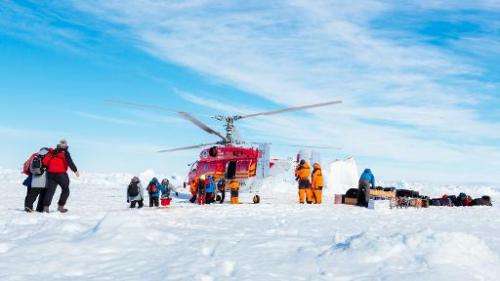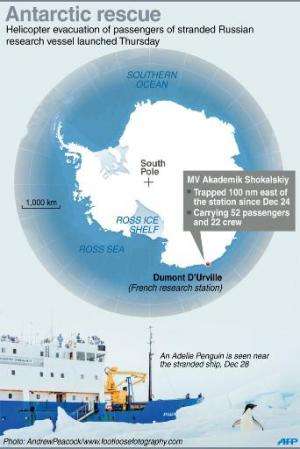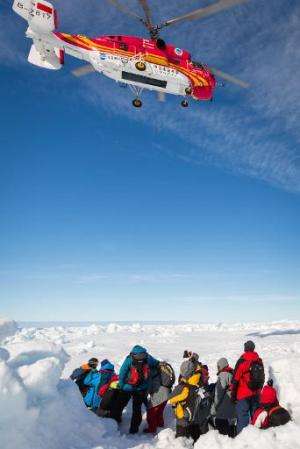Antarctic helicopter rescue underway at icebound ship

A helicopter landed alongside an icebound Russian research ship in Antarctica Thursday and began picking up its 52 trapped passengers, after a number of false starts and failed icebreaking attempts.
The MV Akademik Shokalskiy has been trapped in thick pack ice 100 nautical miles east of the French base Dumont d'Urville since December 24, with several icebreakers forced back to open water by impenetrable floes.
A helicopter rescue was announced on Tuesday, but heavy rain and winds saw it shelved until Thursday morning, when a second attempt was foiled by unfavourable sea ice.
But by late afternoon a favourable window had opened, and expedition leader Chris Turney announced that a helicopter from the Chinese icebreaker Xue Long had arrived at the marooned ship to begin evacuating passengers.
"The Chinese helicopter has arrived at the Shokalskiy. It's 100 percent we're off! A huge thanks to all," Turney tweeted.
His posting was accompanied by footage showing the Xue Long's red helicopter touching down on a landing pad marked out on the ice beside the Akademik Shokalskiy and an orange-suited rescue crew disembarking.
A second video, posted about an hour later and shot from the deck, showed the first group of passengers trekking across the ice to the helicopter, followed by a third depicting the second load taking off.
The Australian Maritime Safety Authority (AMSA) said it received confirmation about 6.15pm Australian time (0715 GMT) that the rescue had begun.

"AMSA understands the plan is to fly from the Russian ship direct to an ice floe adjacent to the Aurora Australis," AMSA said.
"AMSA has received confirmation that the first transfer of 12 passengers to the Aurora Australis has been completed," it added.
The initial plan had been for the helicopter to ferry the passengers back to the Xue Long, where they would board a barge to be transferred to the Aurora Australis, the Australian government's Antarctic resupply ship.
But sea ice prevented the Australis from launching its barge Thursday, forcing a rethink.
Original estimates were for the aerial evacuation to take at least five hours, but that is now likely to be a under-estimate, with the Xue Long some 12 nautical miles distant and the Australis a further two nautical miles away.
AMSA had estimated the return journey from the Xue Long to the Shokalskiy at 45 minutes, with five trips of up to 12 passengers required and another two flights for equipment and luggage.
Even after the rescue is complete it will be some weeks before the passengers reach dry land, with the Australis having to travel via Australia's Casey Antarctic base to refuel.

The ship's 22 crew will remain on board until the ice breaks up and the Shokalskiy can sail on under her own steam. She is well provisioned and those on board have not been in any danger.
The helicopter operation follows several failed icebreaking attempts, with the Xue Long, Aurora Australis and French-flagged L'Astrolabe all forced to turn back by thick ice that they could not break through.
Passengers on the stranded ship—an eclectic mix of scientists, tourists and journalists—had been following in the footsteps of Australian Sir Douglas Mawson and his 1911-1914 expedition.
The team has been carrying out the same scientific experiments that Mawson's group conducted during their expedition, partly in an attempt to discover how quickly the Antarctic's sea ice is disappearing.
Board games, first-aid and other skills courses and walks on the ice have helped to pass the time. They even penned a theme song about their adventure and filmed themselves singing it on the top deck.
Though they are in remote Antarctica the group dropped in on one of the world's biggest New Year's parties, broadcasting live to celebrations in New York's Times Square from their marooned vessel.
© 2014 AFP





















